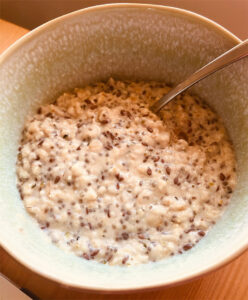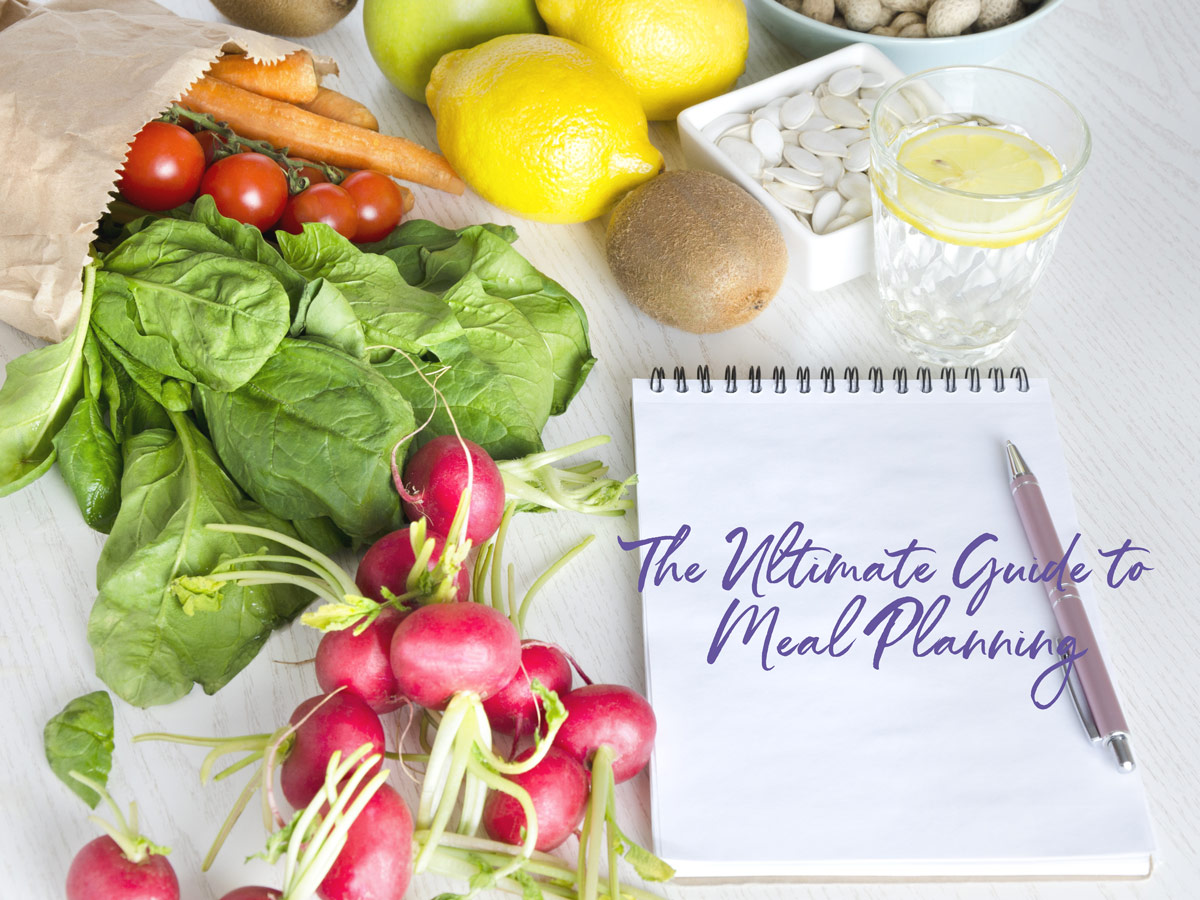We know that the best intentions to eat healthfully are often postponed by busy school, work weeks, urgent needs, parenthood, or life’s unexpected ups and downs. That’s why the time you put towards making a weekly meal plan can increase your health and nutrition while reducing meal prep times, wasted groceries, and even what you spend on food! It’s a no-brainer that you want to develop this skill into a weekly habit. Implement this into your busy schedule, and you’ll reap the rewards!
Do you ever feel like cooking is the last thing you want to do when you get home from a busy day? Having a meal already planned and prepped means you can do it in less time or even delegate it because you (and your family) always know what’s on the menu. Besides saving you time, you’ll improve your nutrition and lifestyle.
In fact, home meal preparation has been linked with improved diet quality. A study in France in 2017 found that meal planners had higher overall food variety and less likelihood of being overweight or obese.
This post will support meal planning for beginners while providing options for more experienced gastronomes. We’ll show you easy-to-implement and fuss-free meal planning basics. When you are looking for tips for building a healthy, balanced meal for the family or yourself, we have all the meal planning tips and tricks and why you need them. And you don’t have to start from scratch – once you finish this guide – you’ll have a meal plan, shopping list and instructions to prep meals ahead of your busy weekday schedule.
Are you ready?
Does this sound like a dream? Imagine having all your meals ready to go for the week, while you reach your nutrition goals and make sure what you are eating is right for you. (Note: If you’re unsure if what you are eating is nutritionally working for you, you have food sensitivities or hormone imbalances, you can take one of our nutritional tests to get to the bottom of these challenges)
And it’s not as hard as you think – once you schedule it in your weekly calendar (I like to do it on a lazy Sunday when I have fun browsing recipes and then planning them in my favorite app) you’ll be on your way to cooking meals that are delicious AND easy.
So exactly what is meal planning, and why is it important?
Meal planning is asking yourself ‘What’s for dinner ONCE per week’ instead of every night when you’re tired and ready to put your feet up after work.
It includes creating your shopping list from the meal plan, then shopping once per week and prepping some ingredients before you need them. Meal planning can be an enjoyable way for bringing the whole family into the menu and assigning tasks, so everyone can contribute to meals, and you aren’t doing all the work yourself. Even if you’re meal planning for one, it means you’ll have extra time each night to relax, and your meals will be more enjoyable, allowing you to savor each bite.
Time and planning may be the essential ingredients for a healthy diet, finds new research in the American Journal of Preventive Medicine.*
This study reinforces what previous studies and nutrition practice tells us: that time is commonly reported as a barrier to healthy eating, and people often don’t feel confident about their ability to prepare healthy meals.
Meal planning can help you with both time and confidence!
Stay tuned in an upcoming blog where we share some of our favorite breakfast, lunch and dinner easy, nutritious (and affordable) recipes!
Here is a sneak peek at what’s to come:

Here are more benefits of meal planning
- When you create your own meal plan, it’s customized towards your particular tastes, food sensitivities or allergies, and nutritional goals or caters to certain health conditions like digestive (IBS or SIBO), hormone imbalances, or pregnancy and lactation…
- You save a lot of time, handling most of the prep for your meals once a week, rather than every night (or skipping it altogether and ordering in).
- Reduces food waste and the money you spend on food.
- Promotes a more balanced diet with better food choices, helping your body reap the benefits of more varied nutrients.
- Reduces stress and increases the enjoyment of food.
Some factors to consider when planning a meal
You might be wondering what the top things are to consider when planning a meal? Here are some factors you’ll want to take into consideration:
- How much time do you have available to cook? Take a look at your week and determine how much time you have to cook each night. Are there meetings or busy nights with activities?
- Consider what food is in season, you can save money cooking with what’s in season.
- Ensure you have a variety of foods or even include new foods you want to try
- Are there any special occasions or certain people in your family who are cooking?
- What are your financial resources, are there certain brands or foods you want to splurge or save on?
- When you’re aiming to save money, it’s a good idea to include breakfast and lunch in your meal plans, so every meal is accounted for, but if you are new to meal planning, just start with dinners-it’s best not to overwhelm yourself! Trust us, you’ll soon be able to add in more meals as you get the hang of it!
What makes a good (aka balanced’) meal plan?
The best meal plans emphasize whole foods, like fruits, vegetables, legumes, whole grains, high-quality proteins, both vegetarian and non-vegetarian), healthy fats as well as fat-free or low-fat dairy products or vegan alternatives. Opt for organic produce when possible. Menu planning principles include balance, nutritional quality, aesthetics, and variety, including color, texture, flavors, shapes, and sizes of food. The equipment available to produce the meals is also an important consideration in planning the weekly meals.
Tips for healthy meal planning:
- Include lean meats, poultry, fish, beans, eggs, and nuts.
- Limit saturated and trans fats, sodium, and added sugars.
- Become aware of portion sizes
- Set a daily meal plan for breakfast, lunch, snacks, and dinner
- Stock your pantry (see our tips below)
- Keep your favorite recipes handy (or use our fave app to save them!)
How do I make a weekly eating plan – and stick to it?
There are 8 basic and simple steps to meal planning so you ensure you have the best plan possible.
Before You Start Planning
- What are your favorite meals, including desserts and sides? Include everyone in the family in this discussion!
- Shop from the pantry, refrigerator, and freezer first. See what you have on hand now, or that needs to be eaten before buying new food. Use your fresh & frozen ingredients strategically. If you’re buying ingredients like fresh cherries, plan to use those at the beginning of the week. Keep fresh produce purchases to what you plan to use within 3 to 4 days, then use frozen ingredients later on in the week.
- Check your calendar to see how much time you have to spend cooking and use it to pick out recipes.
- Check store sales and what’s in season or on sale – some supermarkets offer members-only discounts.
- Schedule in flexi-meals or a busy night – leave some gaps in your meal plan to allow for lunch or dinner out or nights where you will have less cooking time. This way you won’t overspend on groceries that end up going to waste.
When You Return/During The Week
- To preserve freshness and nutrition, use perishables like seafood and meat earlier in the week and save staples (pasta, dairy, omelets) for later in the week. Some greens, like kale and chard, will stay fresh longer than others in your fridge.
- Plan for leftovers – we like to do baked fritters or patties at the end of the week where we can add lots of leftover ingredients to make meals more wholesome!
- Calculate portions so there’s not too much extra (unless you want leftovers).
Mix and match: Choose two types of protein, one or two grains, and a vegetable medley to make at the beginning of the week and incorporate them into different meals. For instance, a sauté of onions and mushrooms can be used as a side one night, spooned onto enchiladas another night, and worked into a soup or meat or veggie loaf later in the week. And don’t forget to treat yourself too!
Schedule in flexi-meals or a busy night – leave some gaps in your meal plan to allow for lunch or dinner out or nights where you will have less cooking time. This way, you won’t overspend on groceries that end up going to waste.
PS: Want to learn more on meal planning and take these foundational topics to the next level? Click here and read the “Easy meal Planning Ideas” Blog. In this blog, we’ll be featuring one of each of our favorite breakfast, lunch and dinner meal prep recipes. We don’t want to leave you completely hanging, so we’re sharing a sneak peak of our delicious breakfast recipe that you can prep in less time without the stress and cleanup.
SNEAK PEEK RECIPE

- Flax seeds & chia seeds
- Organic oats
- Almonds
- Pumpkin seeds
- Sunflower seeds
- Cinnamon
- Cardamon
- Maple syrup (optional)
- Place oatmeal in bowl and add ½ cup hot water just off the boil, you want the water to just cover the top of the oats, as it will get soaked in after a few minutes.
- Stir in spices
- Top with seeds and nuts!





